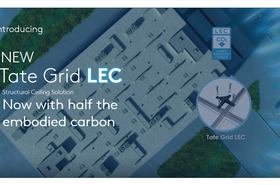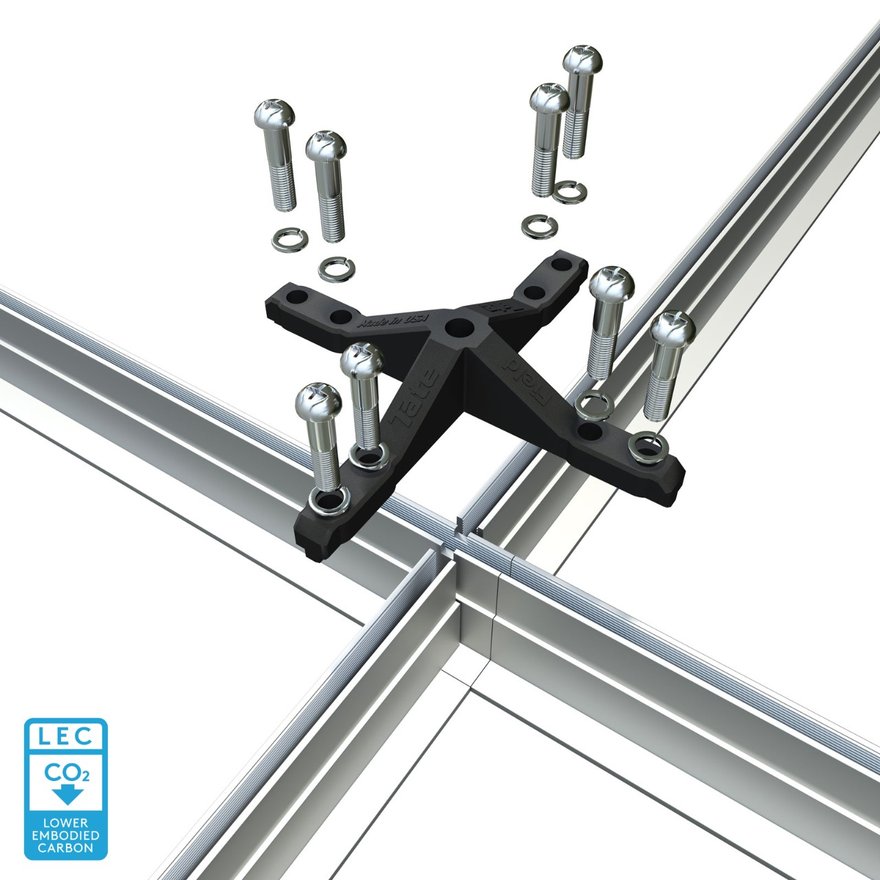As data centers look to meet the exponential demand augmented by the significant infrastructure required to accommodate artificial intelligence (AI) workloads, operators are having to think smarter. The days when lifting a raised floor to duct more cabling are long gone. For colos (co-location sites) with multiple tenants coming and going, and requiring evermore footprint, the problem is only exacerbated.
Gus O’Rourke is specification manager at Tate, part of the Kingspan Group, and a leading exponent of structural ceilings. Earlier this year, Tate launched Tate Grid LEC, a structural ceiling solution that has half the embodied carbon than that of standard Tate Grid. DCD spoke to O’Rourke about why structural ceilings are the solution for colos. In this article, he discusses:
- Why structural ceilings are the preferred solution for modern colo data centers
- How Tate’s ceilings are tested above and beyond industry standards
- Why Tate Grid LEC represents the lower carbon choice
- Considerations for operators when choosing structural ceilings
- How Tate partners work with customers to find a bespoke solution for their needs
- Why Tate is the right partner for your facility
First, we ask, what exactly is a structural ceiling, and why is it the preferred solution in the modern colo data center?
“A structural ceiling is more than a ceiling,” he explains. “It is an innovative system that has been specifically designed and engineered for the data center sector. Tate Grid LEC is now a crucial component within the white space of data centers, which serves a dual purpose. Firstly, acting as a plenum which enhances airflow, as it allows for the distribution of cool air and the efficient removal of hot air, contributing to optimal cooling and energy efficiency within the data center. Secondly, Tate Grid LEC functions as a high-strength platform for the attachment and suspension of critical infrastructure and heavy equipment, empowering ceiling-supported containment, partitions, cable tray attachment, and surface-mounted mechanical and electrical equipment.
The logic of this arrangement is clear to see, as O’Rourke is keen to point out:
“In the early days of data centers, all services were distributed to the server racks via a raised access floor, updating these facilities required lifting the raised access floor panels to access the services underneath the floor, which is an extremely cumbersome and slow process, but this has now been flipped on its head, and structural ceilings are the preferred distribution solution for the majority of colo data centers across Europe, as by suspending infrastructure components, equipment placement is optimized, and the available space within the data hall is used more efficiently.
For colo data centers, structural ceilings make sense, and in the fast-moving world of colos, this is never truer: “Data centers are dynamic environments, which are subject to constant technological advancements and evolving market demands. Tate Grid LEC provides an entirely accessible overhead platform that ensures data center administrators can easily expand, upgrade, or modify distribution systems as required, without cumbersome impediments. This accessibility not only enhances operational efficiency but also contributes to reduced downtime and maintenance costs”.
“Validating suspended loads from a structural ceiling is the first crucial step to ensure that a structural ceiling grid can safely support the critical infrastructure and heavy equipment suspended from this high-strength platform,” O’Rourke tells us more:
“EN 13964:2014 is the European standard for the complete suspended ceiling system, which is a comprehensive standard that covers reaction to fire, sound absorption, thermal conductivity, and more. This includes conducting a simple bend test to the profile in the positive and negative orientations.”
However, EN 13964 does not provide a testing methodology to validate ‘vertical tension loads’, therefore Tate holds primary test evidence to certify suspended loads from their structural ceiling, which has been independently tested and certified. O’Rourke tells us: “It's not an omission of the standard per se, it’s the fact that structural ceilings are a relatively new product to the European Data center sector, we completed our first European structural ceiling project in 2017, which is three years after EN 13964 technical standard had been published in 2014, therefore the testing methodology of structural ceilings could not be considered at the time of writing the technical standard, as the product simply didn’t exist.”
We ask O’Rourke about those additional tests – why they’re needed, what they show, and why they give peace of mind to customers: “In the absence of a unified standard for structural ceilings, the best practice for validating suspended loads is to conduct a full-scale test with all the structural ceiling components. The purpose of a fully assembled structural ceiling is to replicate real-world conditions and observe the behavior of multiple structural components that undergo vertical tension load tests to the weakest point of the structural ceiling, which is the midspan of the unsupported structural tee. Once all the data has been gathered from these suspended load tests, a maximum safe working point load can then be calculated.”
The result allows Tate to say with certainty what represents a safe load to be borne by the ceiling.
“Our maximum safe working point load includes a safety factor which will prevent overloading of the structural ceiling,” he adds.
In other words, Tate’s structural ceilings are far stronger than their specified maximum safe working point load.
“It is crucial that the data center environmental health and safety officers (EHS), Mechanical and Electrical (M&E) consultants, and architects specifying suspended ceilings must thoroughly understand the best practices for validating suspended loads. This ensures they are confident in the strength of the structural ceiling, enabling data center operators to work safely underneath it.”
Tate Grid LEC has been designed to meet all the same specifications as its predecessor but with significantly lower environmental impact during the manufacturing process. O’Rourke sums this up: “Tate Grid LEC has the same load performance, but the aluminum is manufactured using renewable energy rather than electricity generated using fossil fuels. It has the same structural capacity, has the same point load, and has the same maximum safe working point load.”
Quality control is the next crucial step in the manufacturing process of Tate Grid LEC.
“Our structural ceiling systems are CE marked to EN 1090 Execution Class 2, which is the standard for load-bearing structural steel and aluminum, to achieve this certification robust and stringent quality control measures must be in place across the manufacturing processes, which are audited annually by an external accredited body.”
We ask O’Rourke to drill down on the testing process itself: “In the extrusion process a billet of aluminum produces 67 lengths of the structural ceiling profiles and samples are taken from each batch of aluminum. These sample profiles undergo three quality checks, a deflection test, a threaded rod pull test, and a connector pull test. The purpose of the three tests is to ensure that the profiles achieve the required performance values and that there are no defects in the aluminum billet.”
“At Tate, safety isn't just a priority; it's a fundamental value that guides our company,” O’Rourke tells us emphatically. This is an example of the attention to detail that Tate brings to safety. During our talk, it becomes increasingly clear that these load-bearing ceilings represent a responsibility for Tate – one which they take very seriously:
“We are the experts in our field and the architects who we work with trust us to specify the right structural ceiling solutions to meet their client's needs. We deliver on this trust with our dedicated project management team who support the design team from the specification page through to the delivery of the project and beyond.”
Those project managers represent an important part of Tate’s offering, bringing their expertise to the environment and ensuring the product installed is beyond reproach. As Tate continues to grow, its global network of installers and project managers grows with it:
“On every Tate Grid LEC project, our dedicated team of project managers provides safety training to all the personnel who interact with our structural ceiling, to ensure they are aware of how to safely and correctly utilize this high-strength platform. It is extremely important for us not only to engage and educate all the personnel who utilize Tate Grid LEC, but also engage and educate the data center operators who will work under this high-strength platform.”
As with all companies working across territories, Tate recognizes the importance of the mantra of “think global, act local” as it applies to quality and safety. O’Rourke speaks to its global network of local experts: “We have project managers to look after every region, who go to the site and provide services as well. We’re a global company with local knowledge. We have a presence in every area we're dealing with. No region is the same.”
The message from O’Rourke, and Tate, is a simple one. Structural ceilings represent a solution to meet the exponential demand augmented by the significant infrastructure required to accommodate AI workloads for the burgeoning data center industry. However, it cannot be entered into without putting safety, security, sustainability, and responsibility front and center, delivered to support a lower carbon future.
For more about Tate Grid LEC click here
More from Tate
-

Sponsored Sustainable solutions that pack a punch
Tate’s lower-carbon manufacturing is just one example of its environmental ethos
-

Tate launches its latest innovation in structural ceiling solutions by halving embodied carbon
Tate Grid LEC has half the embodied carbon than standard Tate Grid
-



